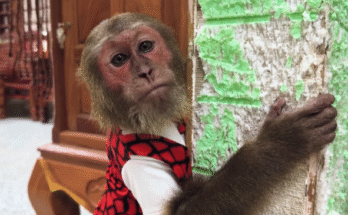In the shadow of the hills, far from the noise of the city, an old, forgotten cemetery rested in eerie silence. Tucked away behind overgrown trees and crumbling gravestones, it had become a wild place—home not just to memories, but to coyotes that prowled under the moonlight. Amid this isolation, a lone dog had made this graveyard her home.
She was first spotted by a local hiker, who saw her darting through the shadows one early morning. Thin and skittish, with fur matted and patchy, the stray dog seemed like a ghost herself. No one knew how long she had been there, but she had clearly learned how to survive among the headstones and avoid the ever-present threat of coyotes. What shocked the hiker most wasn’t just her condition—but her loneliness.
Word spread quickly among local animal lovers, and soon, a group of dedicated rescuers formed a plan. Among them was Jenna, a seasoned rescuer with a soft spot for difficult cases. “This isn’t just any stray,” Jenna said. “She’s smart enough to avoid coyotes and brave enough to live out here alone. But we don’t know how much longer she can survive.”
The team prepared carefully. The cemetery was remote and hard to access, and the coyotes posed a real risk—not just to the dog, but to anyone venturing too far in after dark. Motion-sensitive trail cameras were set up first to track the dog’s movements. For several nights, the rescuers watched heartbreaking footage of the dog—wandering among tombstones, sniffing at empty food wrappers, curling up under a large marble angel for shelter.
The rescuers named her Hope. She was always alone, always alert. But something about her eyes on the camera footage was deeply moving—they weren’t just full of fear. They were full of longing.
To gain her trust, the team began leaving food in safe areas. At first, Hope didn’t touch it until long after they were gone. But gradually, she began to show herself from afar, watching as Jenna set down bowls of water and food. She never approached, but she didn’t run, either. Day by day, her curiosity grew.
Meanwhile, the coyotes grew bolder. On one recording, a pack passed dangerously close to where Hope slept. She didn’t move, simply lay still, her body pressed low to the ground. “It’s a miracle she hasn’t been attacked,” said David, another rescuer. “She’s playing a dangerous game every night.”

After nearly two weeks of gentle coaxing, the team set up a humane trap baited with roast chicken and a soft blanket. Jenna left an old sweater she had worn, hoping the familiar scent might comfort the dog. The rescuers watched nervously from a distance.
That night, the cameras captured Hope circling the trap again and again. She sniffed cautiously, stepped away, came back. Hours passed. Finally, just before sunrise, she stepped inside.
The trap door closed gently behind her.
When the rescuers arrived, they found her curled up, trembling but unharmed. Jenna knelt down and spoke to her softly. “You’re safe now, girl,” she whispered. “No more coyotes. No more lonely nights.”
Hope was rushed to a veterinary clinic, where she was examined thoroughly. She was underweight, dehydrated, and had a few minor injuries likely from thorny underbrush. But miraculously, she had no major wounds. She tested negative for heartworm and other dangerous diseases.
At the clinic, she didn’t growl or snap. She was shy, but calm. “It’s like she knew this was her chance,” the vet said. “Like she’d been waiting for someone to care.”
Credit: Inside Edition
Jenna offered to foster her, and over the following weeks, Hope began to transform. At first, she barely left her crate. She flinched at loud noises and never let anyone touch her belly. But slowly, she began to open up. Her tail started wagging when Jenna came home. She began to nap in sunbeams by the window. She even licked Jenna’s hand one evening after dinner.
The rescue group shared her story online, and people were amazed. Messages poured in from around the world. “She’s so strong,” one comment read. “I can’t believe she survived out there alone.” Others asked to donate, to support her recovery, or to adopt her when she was ready.
Jenna documented each milestone. The first time Hope played with a toy. Her first walk around the block. Her first bark. “She has the softest bark,” Jenna laughed in one video. “Like she’s still learning how to speak again.”
By the end of the second month, Hope had gained weight and confidence. Her fur, once dull and thin, now gleamed in the sun. She chased butterflies in the yard and slept sprawled on her back, a sign she felt safe at last.
Eventually, a kind family from a nearby town, who had followed her story from the beginning, came to meet her. They brought treats, patience, and gentle smiles. Hope approached slowly, sniffed their hands—and then, in a moment that brought tears to everyone’s eyes, she rested her head in the young daughter’s lap.
The adoption was finalized the next week.
Today, Hope lives in a warm home with a big backyard, a soft bed, and two other rescue dogs who’ve become her best friends. She goes on hikes—this time safely, with her family—and sleeps beside her new human sister every night.
The cemetery is quiet again. But for those who remember, it’s not just a place of forgotten stones. It’s the place where a brave dog survived, against all odds, and waited for someone to find her.
And someone did.



